IKC101 Sociology Essay: Indigenous Australians' Contemporary Realities
VerifiedAdded on 2023/03/17
|9
|2240
|37
Essay
AI Summary
This essay, prepared for a sociology course at Charles Sturt University, examines the historical and contemporary realities of Indigenous Australians. It identifies the social, educational, and economic disparities faced by Indigenous populations, attributing these disadvantages to historical events and policies, including the Frontier Wars and the Aborigines Protection Act. The essay highlights the impact of racism, educational inequalities, and the loss of cultural identity, referencing the displacement of Indigenous people and the denial of their rights. It emphasizes the lasting effects of these events, such as trauma, mistrust, and limited access to life skills. The essay uses various scholarly sources to support its arguments, aiming to provide a comprehensive understanding of the challenges faced by Indigenous Australians.
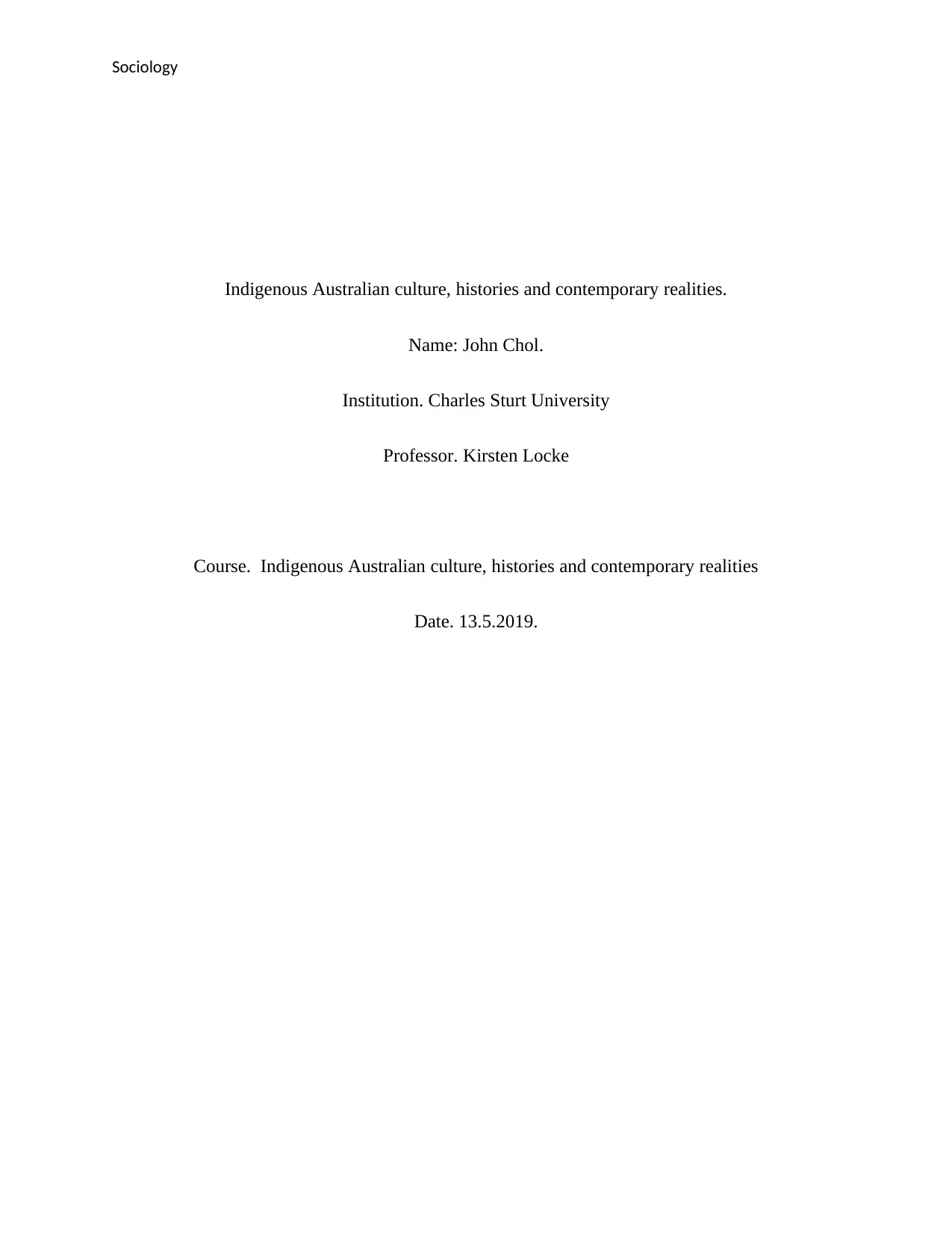
Sociology
Indigenous Australian culture, histories and contemporary realities.
Name: John Chol.
Institution. Charles Sturt University
Professor. Kirsten Locke
Course. Indigenous Australian culture, histories and contemporary realities
Date. 13.5.2019.
Indigenous Australian culture, histories and contemporary realities.
Name: John Chol.
Institution. Charles Sturt University
Professor. Kirsten Locke
Course. Indigenous Australian culture, histories and contemporary realities
Date. 13.5.2019.
Paraphrase This Document
Need a fresh take? Get an instant paraphrase of this document with our AI Paraphraser
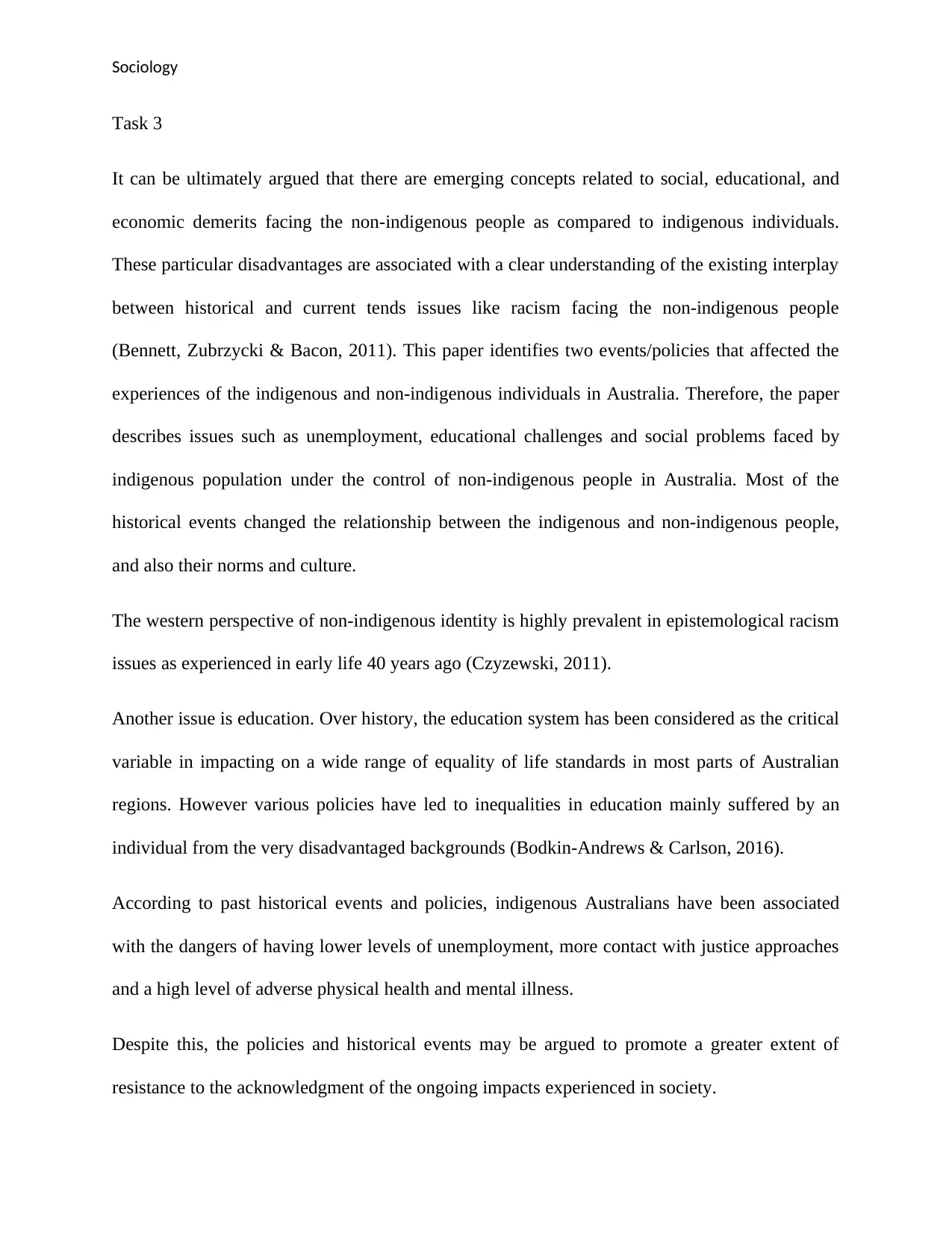
Sociology
Task 3
It can be ultimately argued that there are emerging concepts related to social, educational, and
economic demerits facing the non-indigenous people as compared to indigenous individuals.
These particular disadvantages are associated with a clear understanding of the existing interplay
between historical and current tends issues like racism facing the non-indigenous people
(Bennett, Zubrzycki & Bacon, 2011). This paper identifies two events/policies that affected the
experiences of the indigenous and non-indigenous individuals in Australia. Therefore, the paper
describes issues such as unemployment, educational challenges and social problems faced by
indigenous population under the control of non-indigenous people in Australia. Most of the
historical events changed the relationship between the indigenous and non-indigenous people,
and also their norms and culture.
The western perspective of non-indigenous identity is highly prevalent in epistemological racism
issues as experienced in early life 40 years ago (Czyzewski, 2011).
Another issue is education. Over history, the education system has been considered as the critical
variable in impacting on a wide range of equality of life standards in most parts of Australian
regions. However various policies have led to inequalities in education mainly suffered by an
individual from the very disadvantaged backgrounds (Bodkin-Andrews & Carlson, 2016).
According to past historical events and policies, indigenous Australians have been associated
with the dangers of having lower levels of unemployment, more contact with justice approaches
and a high level of adverse physical health and mental illness.
Despite this, the policies and historical events may be argued to promote a greater extent of
resistance to the acknowledgment of the ongoing impacts experienced in society.
Task 3
It can be ultimately argued that there are emerging concepts related to social, educational, and
economic demerits facing the non-indigenous people as compared to indigenous individuals.
These particular disadvantages are associated with a clear understanding of the existing interplay
between historical and current tends issues like racism facing the non-indigenous people
(Bennett, Zubrzycki & Bacon, 2011). This paper identifies two events/policies that affected the
experiences of the indigenous and non-indigenous individuals in Australia. Therefore, the paper
describes issues such as unemployment, educational challenges and social problems faced by
indigenous population under the control of non-indigenous people in Australia. Most of the
historical events changed the relationship between the indigenous and non-indigenous people,
and also their norms and culture.
The western perspective of non-indigenous identity is highly prevalent in epistemological racism
issues as experienced in early life 40 years ago (Czyzewski, 2011).
Another issue is education. Over history, the education system has been considered as the critical
variable in impacting on a wide range of equality of life standards in most parts of Australian
regions. However various policies have led to inequalities in education mainly suffered by an
individual from the very disadvantaged backgrounds (Bodkin-Andrews & Carlson, 2016).
According to past historical events and policies, indigenous Australians have been associated
with the dangers of having lower levels of unemployment, more contact with justice approaches
and a high level of adverse physical health and mental illness.
Despite this, the policies and historical events may be argued to promote a greater extent of
resistance to the acknowledgment of the ongoing impacts experienced in society.
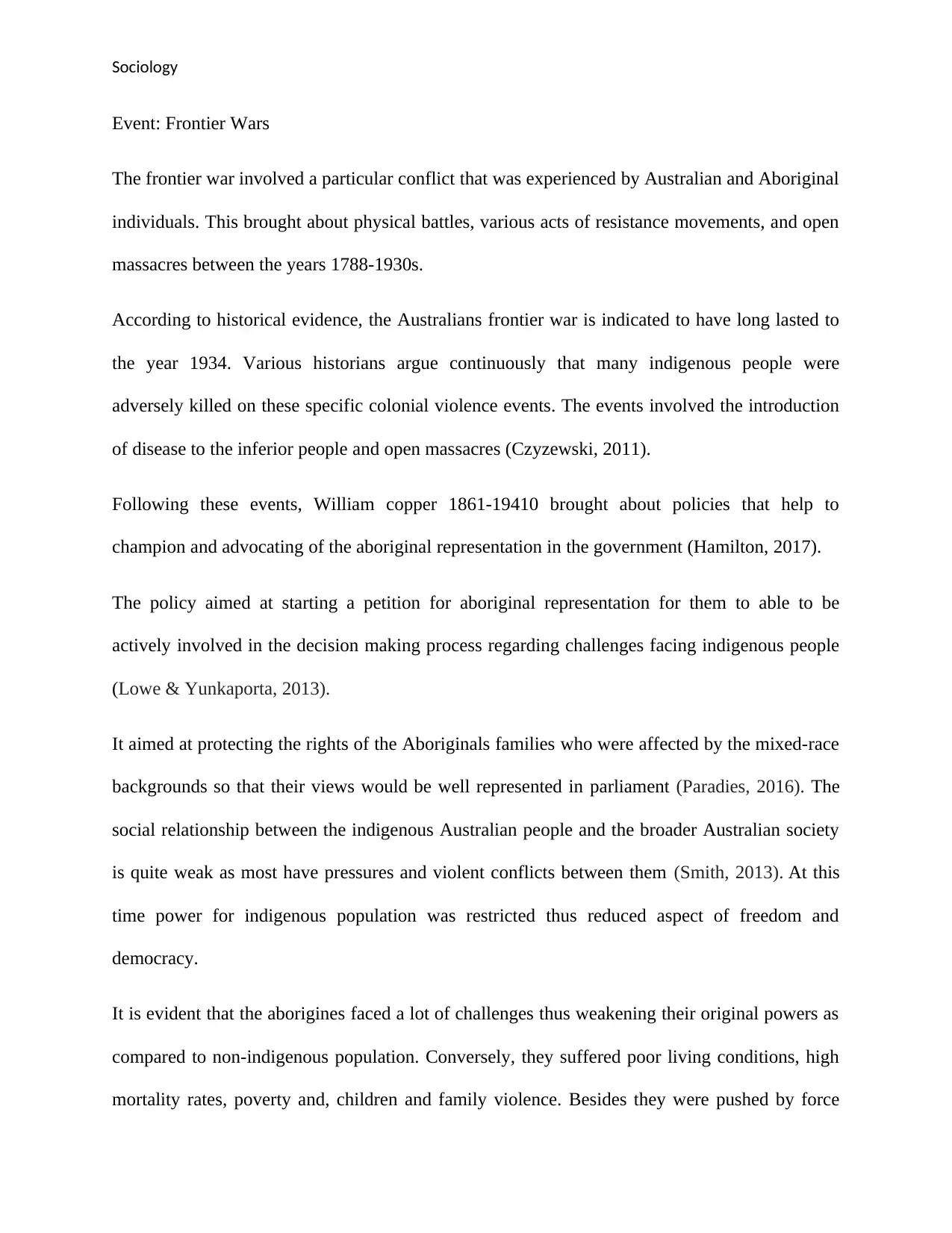
Sociology
Event: Frontier Wars
The frontier war involved a particular conflict that was experienced by Australian and Aboriginal
individuals. This brought about physical battles, various acts of resistance movements, and open
massacres between the years 1788-1930s.
According to historical evidence, the Australians frontier war is indicated to have long lasted to
the year 1934. Various historians argue continuously that many indigenous people were
adversely killed on these specific colonial violence events. The events involved the introduction
of disease to the inferior people and open massacres (Czyzewski, 2011).
Following these events, William copper 1861-19410 brought about policies that help to
champion and advocating of the aboriginal representation in the government (Hamilton, 2017).
The policy aimed at starting a petition for aboriginal representation for them to able to be
actively involved in the decision making process regarding challenges facing indigenous people
(Lowe & Yunkaporta, 2013).
It aimed at protecting the rights of the Aboriginals families who were affected by the mixed-race
backgrounds so that their views would be well represented in parliament (Paradies, 2016). The
social relationship between the indigenous Australian people and the broader Australian society
is quite weak as most have pressures and violent conflicts between them (Smith, 2013). At this
time power for indigenous population was restricted thus reduced aspect of freedom and
democracy.
It is evident that the aborigines faced a lot of challenges thus weakening their original powers as
compared to non-indigenous population. Conversely, they suffered poor living conditions, high
mortality rates, poverty and, children and family violence. Besides they were pushed by force
Event: Frontier Wars
The frontier war involved a particular conflict that was experienced by Australian and Aboriginal
individuals. This brought about physical battles, various acts of resistance movements, and open
massacres between the years 1788-1930s.
According to historical evidence, the Australians frontier war is indicated to have long lasted to
the year 1934. Various historians argue continuously that many indigenous people were
adversely killed on these specific colonial violence events. The events involved the introduction
of disease to the inferior people and open massacres (Czyzewski, 2011).
Following these events, William copper 1861-19410 brought about policies that help to
champion and advocating of the aboriginal representation in the government (Hamilton, 2017).
The policy aimed at starting a petition for aboriginal representation for them to able to be
actively involved in the decision making process regarding challenges facing indigenous people
(Lowe & Yunkaporta, 2013).
It aimed at protecting the rights of the Aboriginals families who were affected by the mixed-race
backgrounds so that their views would be well represented in parliament (Paradies, 2016). The
social relationship between the indigenous Australian people and the broader Australian society
is quite weak as most have pressures and violent conflicts between them (Smith, 2013). At this
time power for indigenous population was restricted thus reduced aspect of freedom and
democracy.
It is evident that the aborigines faced a lot of challenges thus weakening their original powers as
compared to non-indigenous population. Conversely, they suffered poor living conditions, high
mortality rates, poverty and, children and family violence. Besides they were pushed by force
⊘ This is a preview!⊘
Do you want full access?
Subscribe today to unlock all pages.

Trusted by 1+ million students worldwide
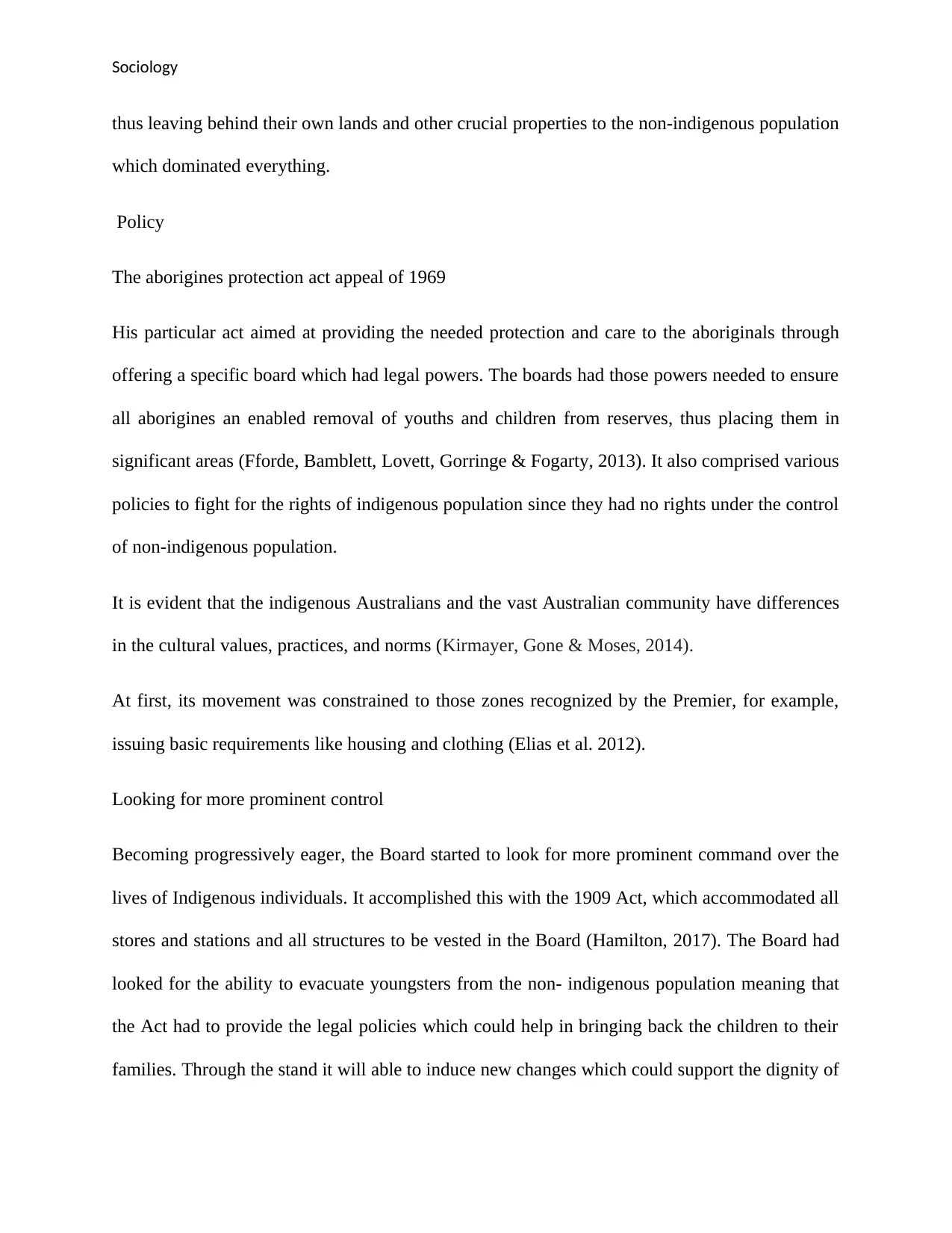
Sociology
thus leaving behind their own lands and other crucial properties to the non-indigenous population
which dominated everything.
Policy
The aborigines protection act appeal of 1969
His particular act aimed at providing the needed protection and care to the aboriginals through
offering a specific board which had legal powers. The boards had those powers needed to ensure
all aborigines an enabled removal of youths and children from reserves, thus placing them in
significant areas (Fforde, Bamblett, Lovett, Gorringe & Fogarty, 2013). It also comprised various
policies to fight for the rights of indigenous population since they had no rights under the control
of non-indigenous population.
It is evident that the indigenous Australians and the vast Australian community have differences
in the cultural values, practices, and norms (Kirmayer, Gone & Moses, 2014).
At first, its movement was constrained to those zones recognized by the Premier, for example,
issuing basic requirements like housing and clothing (Elias et al. 2012).
Looking for more prominent control
Becoming progressively eager, the Board started to look for more prominent command over the
lives of Indigenous individuals. It accomplished this with the 1909 Act, which accommodated all
stores and stations and all structures to be vested in the Board (Hamilton, 2017). The Board had
looked for the ability to evacuate youngsters from the non- indigenous population meaning that
the Act had to provide the legal policies which could help in bringing back the children to their
families. Through the stand it will able to induce new changes which could support the dignity of
thus leaving behind their own lands and other crucial properties to the non-indigenous population
which dominated everything.
Policy
The aborigines protection act appeal of 1969
His particular act aimed at providing the needed protection and care to the aboriginals through
offering a specific board which had legal powers. The boards had those powers needed to ensure
all aborigines an enabled removal of youths and children from reserves, thus placing them in
significant areas (Fforde, Bamblett, Lovett, Gorringe & Fogarty, 2013). It also comprised various
policies to fight for the rights of indigenous population since they had no rights under the control
of non-indigenous population.
It is evident that the indigenous Australians and the vast Australian community have differences
in the cultural values, practices, and norms (Kirmayer, Gone & Moses, 2014).
At first, its movement was constrained to those zones recognized by the Premier, for example,
issuing basic requirements like housing and clothing (Elias et al. 2012).
Looking for more prominent control
Becoming progressively eager, the Board started to look for more prominent command over the
lives of Indigenous individuals. It accomplished this with the 1909 Act, which accommodated all
stores and stations and all structures to be vested in the Board (Hamilton, 2017). The Board had
looked for the ability to evacuate youngsters from the non- indigenous population meaning that
the Act had to provide the legal policies which could help in bringing back the children to their
families. Through the stand it will able to induce new changes which could support the dignity of
Paraphrase This Document
Need a fresh take? Get an instant paraphrase of this document with our AI Paraphraser
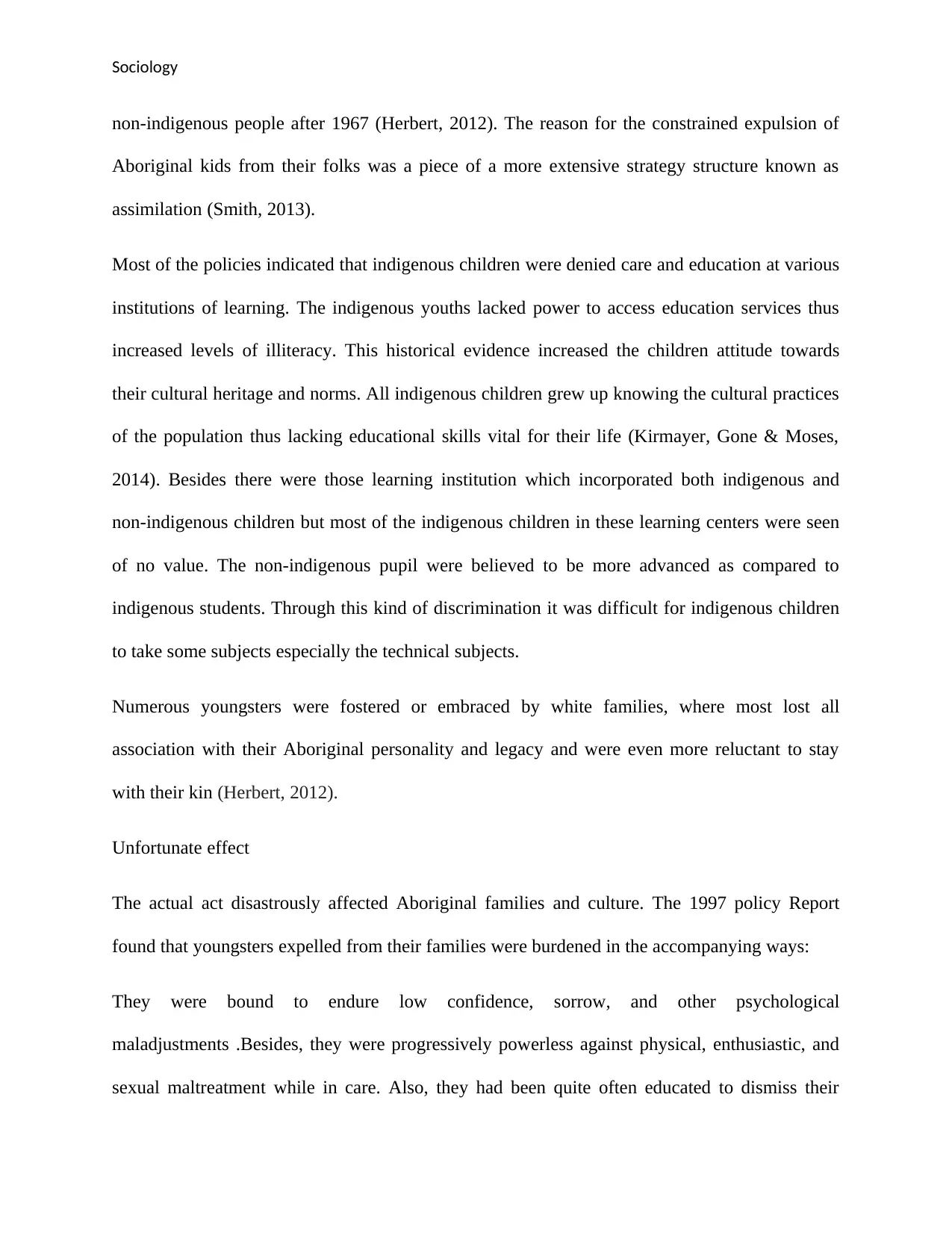
Sociology
non-indigenous people after 1967 (Herbert, 2012). The reason for the constrained expulsion of
Aboriginal kids from their folks was a piece of a more extensive strategy structure known as
assimilation (Smith, 2013).
Most of the policies indicated that indigenous children were denied care and education at various
institutions of learning. The indigenous youths lacked power to access education services thus
increased levels of illiteracy. This historical evidence increased the children attitude towards
their cultural heritage and norms. All indigenous children grew up knowing the cultural practices
of the population thus lacking educational skills vital for their life (Kirmayer, Gone & Moses,
2014). Besides there were those learning institution which incorporated both indigenous and
non-indigenous children but most of the indigenous children in these learning centers were seen
of no value. The non-indigenous pupil were believed to be more advanced as compared to
indigenous students. Through this kind of discrimination it was difficult for indigenous children
to take some subjects especially the technical subjects.
Numerous youngsters were fostered or embraced by white families, where most lost all
association with their Aboriginal personality and legacy and were even more reluctant to stay
with their kin (Herbert, 2012).
Unfortunate effect
The actual act disastrously affected Aboriginal families and culture. The 1997 policy Report
found that youngsters expelled from their families were burdened in the accompanying ways:
They were bound to endure low confidence, sorrow, and other psychological
maladjustments .Besides, they were progressively powerless against physical, enthusiastic, and
sexual maltreatment while in care. Also, they had been quite often educated to dismiss their
non-indigenous people after 1967 (Herbert, 2012). The reason for the constrained expulsion of
Aboriginal kids from their folks was a piece of a more extensive strategy structure known as
assimilation (Smith, 2013).
Most of the policies indicated that indigenous children were denied care and education at various
institutions of learning. The indigenous youths lacked power to access education services thus
increased levels of illiteracy. This historical evidence increased the children attitude towards
their cultural heritage and norms. All indigenous children grew up knowing the cultural practices
of the population thus lacking educational skills vital for their life (Kirmayer, Gone & Moses,
2014). Besides there were those learning institution which incorporated both indigenous and
non-indigenous children but most of the indigenous children in these learning centers were seen
of no value. The non-indigenous pupil were believed to be more advanced as compared to
indigenous students. Through this kind of discrimination it was difficult for indigenous children
to take some subjects especially the technical subjects.
Numerous youngsters were fostered or embraced by white families, where most lost all
association with their Aboriginal personality and legacy and were even more reluctant to stay
with their kin (Herbert, 2012).
Unfortunate effect
The actual act disastrously affected Aboriginal families and culture. The 1997 policy Report
found that youngsters expelled from their families were burdened in the accompanying ways:
They were bound to endure low confidence, sorrow, and other psychological
maladjustments .Besides, they were progressively powerless against physical, enthusiastic, and
sexual maltreatment while in care. Also, they had been quite often educated to dismiss their
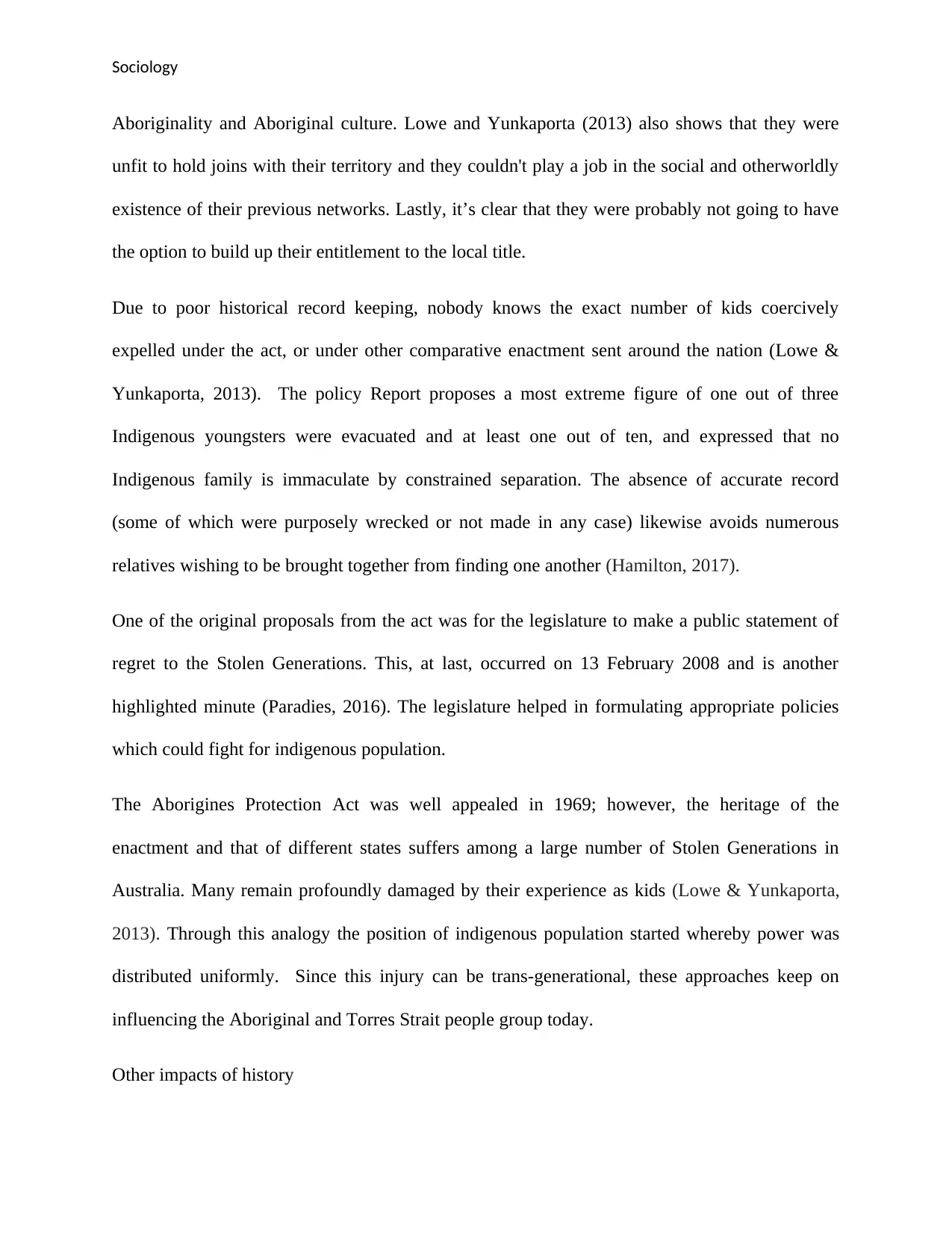
Sociology
Aboriginality and Aboriginal culture. Lowe and Yunkaporta (2013) also shows that they were
unfit to hold joins with their territory and they couldn't play a job in the social and otherworldly
existence of their previous networks. Lastly, it’s clear that they were probably not going to have
the option to build up their entitlement to the local title.
Due to poor historical record keeping, nobody knows the exact number of kids coercively
expelled under the act, or under other comparative enactment sent around the nation (Lowe &
Yunkaporta, 2013). The policy Report proposes a most extreme figure of one out of three
Indigenous youngsters were evacuated and at least one out of ten, and expressed that no
Indigenous family is immaculate by constrained separation. The absence of accurate record
(some of which were purposely wrecked or not made in any case) likewise avoids numerous
relatives wishing to be brought together from finding one another (Hamilton, 2017).
One of the original proposals from the act was for the legislature to make a public statement of
regret to the Stolen Generations. This, at last, occurred on 13 February 2008 and is another
highlighted minute (Paradies, 2016). The legislature helped in formulating appropriate policies
which could fight for indigenous population.
The Aborigines Protection Act was well appealed in 1969; however, the heritage of the
enactment and that of different states suffers among a large number of Stolen Generations in
Australia. Many remain profoundly damaged by their experience as kids (Lowe & Yunkaporta,
2013). Through this analogy the position of indigenous population started whereby power was
distributed uniformly. Since this injury can be trans-generational, these approaches keep on
influencing the Aboriginal and Torres Strait people group today.
Other impacts of history
Aboriginality and Aboriginal culture. Lowe and Yunkaporta (2013) also shows that they were
unfit to hold joins with their territory and they couldn't play a job in the social and otherworldly
existence of their previous networks. Lastly, it’s clear that they were probably not going to have
the option to build up their entitlement to the local title.
Due to poor historical record keeping, nobody knows the exact number of kids coercively
expelled under the act, or under other comparative enactment sent around the nation (Lowe &
Yunkaporta, 2013). The policy Report proposes a most extreme figure of one out of three
Indigenous youngsters were evacuated and at least one out of ten, and expressed that no
Indigenous family is immaculate by constrained separation. The absence of accurate record
(some of which were purposely wrecked or not made in any case) likewise avoids numerous
relatives wishing to be brought together from finding one another (Hamilton, 2017).
One of the original proposals from the act was for the legislature to make a public statement of
regret to the Stolen Generations. This, at last, occurred on 13 February 2008 and is another
highlighted minute (Paradies, 2016). The legislature helped in formulating appropriate policies
which could fight for indigenous population.
The Aborigines Protection Act was well appealed in 1969; however, the heritage of the
enactment and that of different states suffers among a large number of Stolen Generations in
Australia. Many remain profoundly damaged by their experience as kids (Lowe & Yunkaporta,
2013). Through this analogy the position of indigenous population started whereby power was
distributed uniformly. Since this injury can be trans-generational, these approaches keep on
influencing the Aboriginal and Torres Strait people group today.
Other impacts of history
⊘ This is a preview!⊘
Do you want full access?
Subscribe today to unlock all pages.

Trusted by 1+ million students worldwide
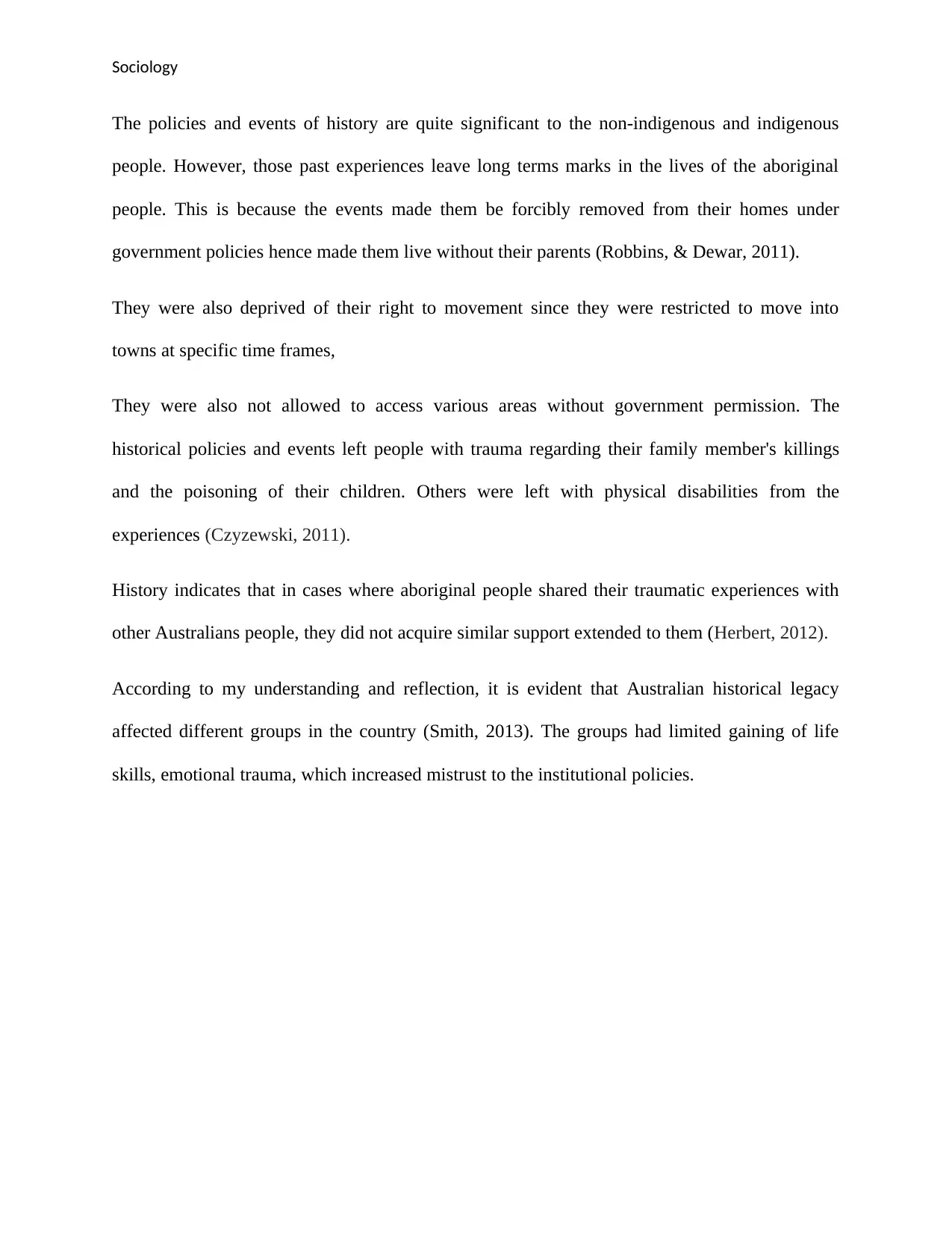
Sociology
The policies and events of history are quite significant to the non-indigenous and indigenous
people. However, those past experiences leave long terms marks in the lives of the aboriginal
people. This is because the events made them be forcibly removed from their homes under
government policies hence made them live without their parents (Robbins, & Dewar, 2011).
They were also deprived of their right to movement since they were restricted to move into
towns at specific time frames,
They were also not allowed to access various areas without government permission. The
historical policies and events left people with trauma regarding their family member's killings
and the poisoning of their children. Others were left with physical disabilities from the
experiences (Czyzewski, 2011).
History indicates that in cases where aboriginal people shared their traumatic experiences with
other Australians people, they did not acquire similar support extended to them (Herbert, 2012).
According to my understanding and reflection, it is evident that Australian historical legacy
affected different groups in the country (Smith, 2013). The groups had limited gaining of life
skills, emotional trauma, which increased mistrust to the institutional policies.
The policies and events of history are quite significant to the non-indigenous and indigenous
people. However, those past experiences leave long terms marks in the lives of the aboriginal
people. This is because the events made them be forcibly removed from their homes under
government policies hence made them live without their parents (Robbins, & Dewar, 2011).
They were also deprived of their right to movement since they were restricted to move into
towns at specific time frames,
They were also not allowed to access various areas without government permission. The
historical policies and events left people with trauma regarding their family member's killings
and the poisoning of their children. Others were left with physical disabilities from the
experiences (Czyzewski, 2011).
History indicates that in cases where aboriginal people shared their traumatic experiences with
other Australians people, they did not acquire similar support extended to them (Herbert, 2012).
According to my understanding and reflection, it is evident that Australian historical legacy
affected different groups in the country (Smith, 2013). The groups had limited gaining of life
skills, emotional trauma, which increased mistrust to the institutional policies.
Paraphrase This Document
Need a fresh take? Get an instant paraphrase of this document with our AI Paraphraser
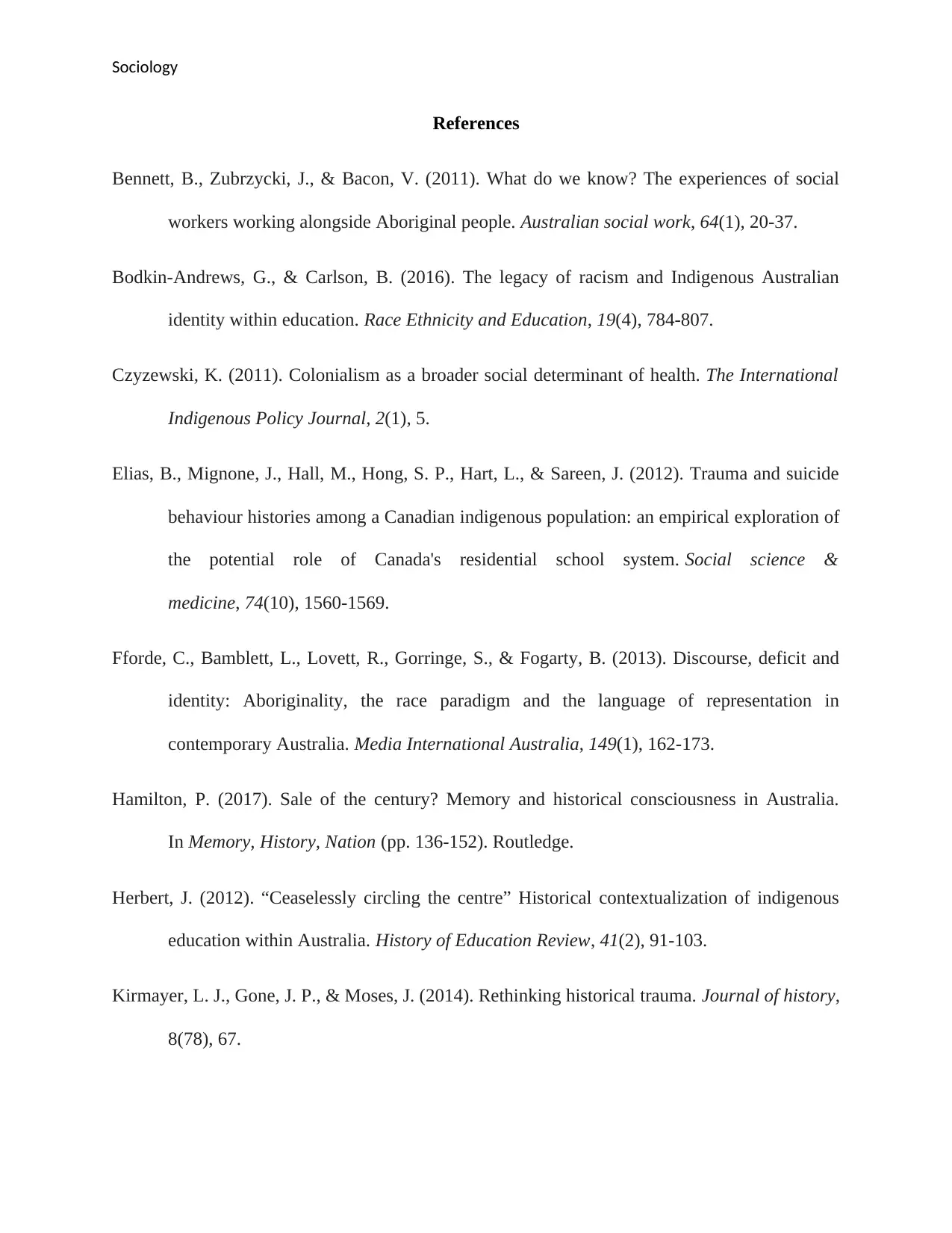
Sociology
References
Bennett, B., Zubrzycki, J., & Bacon, V. (2011). What do we know? The experiences of social
workers working alongside Aboriginal people. Australian social work, 64(1), 20-37.
Bodkin-Andrews, G., & Carlson, B. (2016). The legacy of racism and Indigenous Australian
identity within education. Race Ethnicity and Education, 19(4), 784-807.
Czyzewski, K. (2011). Colonialism as a broader social determinant of health. The International
Indigenous Policy Journal, 2(1), 5.
Elias, B., Mignone, J., Hall, M., Hong, S. P., Hart, L., & Sareen, J. (2012). Trauma and suicide
behaviour histories among a Canadian indigenous population: an empirical exploration of
the potential role of Canada's residential school system. Social science &
medicine, 74(10), 1560-1569.
Fforde, C., Bamblett, L., Lovett, R., Gorringe, S., & Fogarty, B. (2013). Discourse, deficit and
identity: Aboriginality, the race paradigm and the language of representation in
contemporary Australia. Media International Australia, 149(1), 162-173.
Hamilton, P. (2017). Sale of the century? Memory and historical consciousness in Australia.
In Memory, History, Nation (pp. 136-152). Routledge.
Herbert, J. (2012). “Ceaselessly circling the centre” Historical contextualization of indigenous
education within Australia. History of Education Review, 41(2), 91-103.
Kirmayer, L. J., Gone, J. P., & Moses, J. (2014). Rethinking historical trauma. Journal of history,
8(78), 67.
References
Bennett, B., Zubrzycki, J., & Bacon, V. (2011). What do we know? The experiences of social
workers working alongside Aboriginal people. Australian social work, 64(1), 20-37.
Bodkin-Andrews, G., & Carlson, B. (2016). The legacy of racism and Indigenous Australian
identity within education. Race Ethnicity and Education, 19(4), 784-807.
Czyzewski, K. (2011). Colonialism as a broader social determinant of health. The International
Indigenous Policy Journal, 2(1), 5.
Elias, B., Mignone, J., Hall, M., Hong, S. P., Hart, L., & Sareen, J. (2012). Trauma and suicide
behaviour histories among a Canadian indigenous population: an empirical exploration of
the potential role of Canada's residential school system. Social science &
medicine, 74(10), 1560-1569.
Fforde, C., Bamblett, L., Lovett, R., Gorringe, S., & Fogarty, B. (2013). Discourse, deficit and
identity: Aboriginality, the race paradigm and the language of representation in
contemporary Australia. Media International Australia, 149(1), 162-173.
Hamilton, P. (2017). Sale of the century? Memory and historical consciousness in Australia.
In Memory, History, Nation (pp. 136-152). Routledge.
Herbert, J. (2012). “Ceaselessly circling the centre” Historical contextualization of indigenous
education within Australia. History of Education Review, 41(2), 91-103.
Kirmayer, L. J., Gone, J. P., & Moses, J. (2014). Rethinking historical trauma. Journal of history,
8(78), 67.
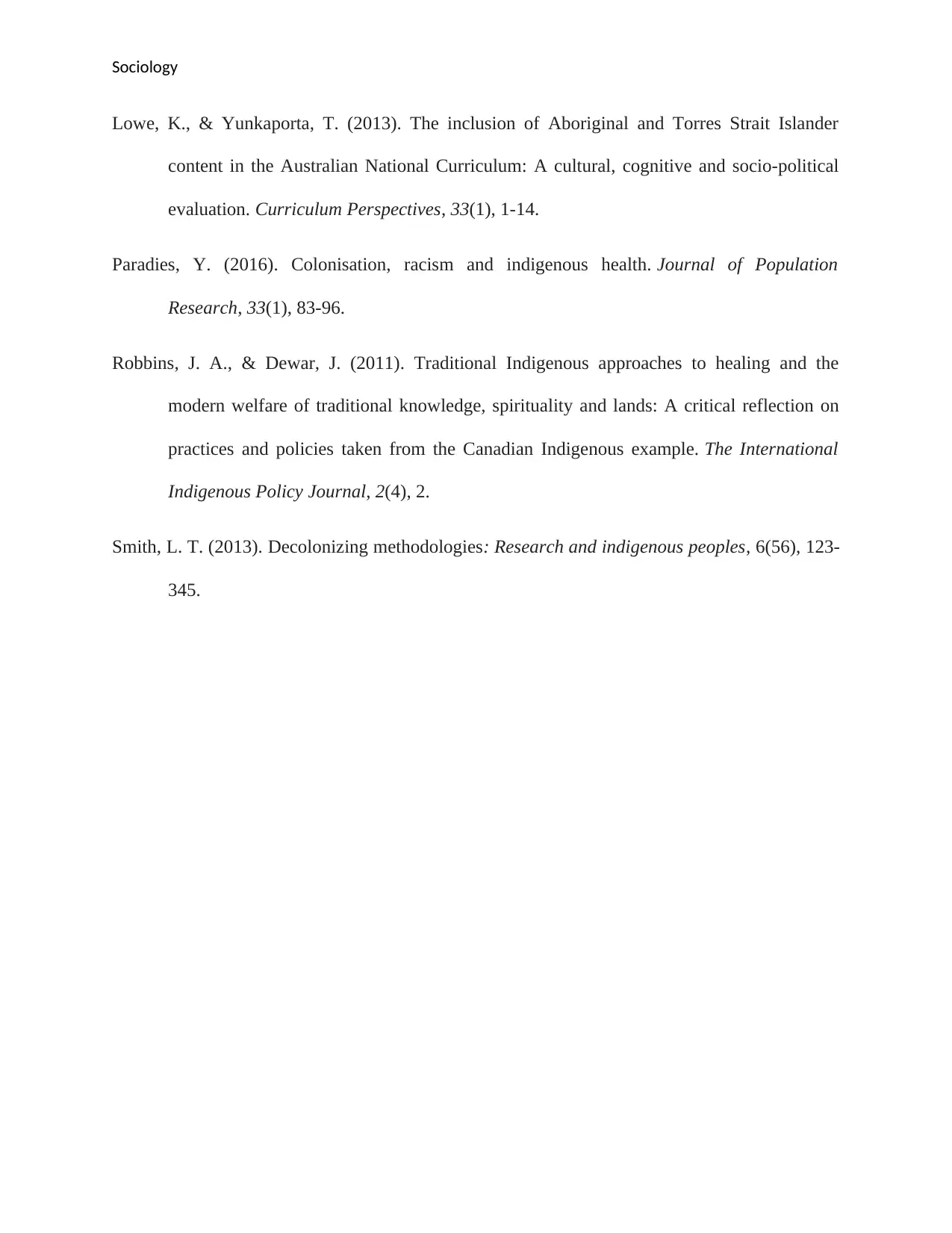
Sociology
Lowe, K., & Yunkaporta, T. (2013). The inclusion of Aboriginal and Torres Strait Islander
content in the Australian National Curriculum: A cultural, cognitive and socio-political
evaluation. Curriculum Perspectives, 33(1), 1-14.
Paradies, Y. (2016). Colonisation, racism and indigenous health. Journal of Population
Research, 33(1), 83-96.
Robbins, J. A., & Dewar, J. (2011). Traditional Indigenous approaches to healing and the
modern welfare of traditional knowledge, spirituality and lands: A critical reflection on
practices and policies taken from the Canadian Indigenous example. The International
Indigenous Policy Journal, 2(4), 2.
Smith, L. T. (2013). Decolonizing methodologies: Research and indigenous peoples, 6(56), 123-
345.
Lowe, K., & Yunkaporta, T. (2013). The inclusion of Aboriginal and Torres Strait Islander
content in the Australian National Curriculum: A cultural, cognitive and socio-political
evaluation. Curriculum Perspectives, 33(1), 1-14.
Paradies, Y. (2016). Colonisation, racism and indigenous health. Journal of Population
Research, 33(1), 83-96.
Robbins, J. A., & Dewar, J. (2011). Traditional Indigenous approaches to healing and the
modern welfare of traditional knowledge, spirituality and lands: A critical reflection on
practices and policies taken from the Canadian Indigenous example. The International
Indigenous Policy Journal, 2(4), 2.
Smith, L. T. (2013). Decolonizing methodologies: Research and indigenous peoples, 6(56), 123-
345.
⊘ This is a preview!⊘
Do you want full access?
Subscribe today to unlock all pages.

Trusted by 1+ million students worldwide
1 out of 9
Related Documents
Your All-in-One AI-Powered Toolkit for Academic Success.
+13062052269
info@desklib.com
Available 24*7 on WhatsApp / Email
![[object Object]](/_next/static/media/star-bottom.7253800d.svg)
Unlock your academic potential
Copyright © 2020–2025 A2Z Services. All Rights Reserved. Developed and managed by ZUCOL.





